We’re back! After a bit of a break, your regularly scheduled Flash Forward episodes will resume starting today. Every other Tuesday you’ll get a future delivered straight to your listening device. I hope you enjoy!
On this episode, we’re talking about the future of senior care. Namely: what happens when we outsource care for our aging loved ones to robots, apps and devices?
Let’s start by defining the challenge that the technology in today’s episode is trying to solve: in the United States, there are six million people over the age of 85. Experts estimate that, by 2050, that number will jump to 19 million. And a question looms over those numbers, right? Who’s going to take care of us? And who is going to pay for our care? The average cost of a year in a nursing home in the United States is over $80,000. In home services provided by humans are $48,000. At the same time, care facilities are already reporting a shortage of qualified nurses.
So of course one of the classes of solutions proposed to this looming problem is technology. There are already apps to monitor and assist seniors, robots to remind them to take their meds, and sensors to predict when they might fall. There are even little robot animals that can provide them with affection and comfort. But what do we give up when we hand our parents over to robots? What do they want? And are the products that tech people are coming up with actually solving the problem at all? Those are the questions of today’s episode. To answer them I talk to:
- Tim Buntel, a tech guy who is also the primary caretaker for his mom
- Jared Go, Co-founder and Chief Technology Officer of OhmniLabs
- Victor Wang, CEO of Care.Coach
- Anab Jain, Co-founder and Director of Superflux
- Wendy Rogers, Professor at University of Illinois
- Lois, my boyfriend’s grandmother
Here’s the video that Superflux made, Uninvited Guests, that I talk about in the episode.
Further reading:
- The ethics of wearable technology and senior care
- Uninvited Guests
- Elder care on-demand: why tech is setting its sights on your parents
- What Happens When We Let Tech Care For Our Aging Parents
- Domestic Robots for Older Adults: Attitudes, Preferences, and Potential
- SAM Brings Much-Needed Robotic Assistance to Senior Living Facilities
- Japan’s long-term care dilemma: Immigrants or robots?
Flash Forward is produced by me, Rose Eveleth. The intro music is by Asura and the outtro music is by Hussalonia. The voice of the annoyed father in the intro was played by Brent Rose. The episode art is by Matt Lubchansky.
If you want to suggest a future we should take on, send us a note on Twitter, Facebook or by email at info@flashforwardpod.com. We love hearing your ideas! And if you think you’ve spotted one of the little references I’ve hidden in the episode, email us there too. If you’re right, I’ll send you something cool.
And if you want to support the show, there are a few ways you can do that too! Head to www.flashforwardpod.com/support for more about how to give. But if that’s not in the cards for you, you can head to Apple Podcasts and leave us a nice review or just tell your friends about us. Those things really do help.
That’s all for this future, come back next time and we’ll travel to a new one.
FULL TRANSCRIPT BELOW
▹▹ ▹▹ ▹▹ ▹▹ ▹▹ ▹▹ ▹▹ ▹▹ ▹▹ ▹▹ ▹▹ ▹▹ ▹▹ ▹▹ ▹▹ ▹▹ ▹▹ ▹▹ ▹▹ ▹▹ ▹▹ ▹▹ ▹▹
Hello and welcome to Flash Forward! I’m Rose and I’m your host, and we’re back! This is the first episode of Season 4, which doesn’t really mean anything actually, it’s just that I’ve been on a break for a bit. So, if you’re just joining us, Flash Forward is a show about the future. Every episode we take on a specific possible… or not so possible future scenario. We always start with a little field trip to the future, to check out what’s going on, and then we teleport back to today to talk to experts about how that world we just heard might really go down. Got it? Great!
Before we go to the future I have a couple of little announcements. This is the first episode of the season, after all. Got to do some housekeeping.
First: there is a very, very cool new store for Flash Forward. If you have ever wanted to buy cool Flash Forward stuff, like pins and stickers and t-shirts, now you can do that! I’ve teamed up with the amazing people at Topataco to sell all sorts of stuff. Just go to FlashForwardPod.com/MERCH and you can find everything that’s for sale there.
Okay, that’s all the announcements I have! Now let’s get on with the show and go to the future.
This episode we’re starting in the year 2043.
[car door opening, wind, walking]
[key FOB beep, facility opening, closing]
[walking down a hall, faint classical playing]
Woman: Okay dad, your room is just down the hall over here.
[opening door, putting down bags]
Woman: So, (more shuffling) remember this? From when we visited?
(slightly sad, dad is giving you the silent treatment) [sigh] Come on dad, this is a great place. State of the art! Watch this.
(wheel noises)
Robot: Hello Mr. Jones. My name is ALEX. I am here to assist you. Before we begin, please let me inform you of a few of our policies. Here at Vanguard Estates we are committed to providing the very best care for our senior residents. At our state of the art facility, your care is coordinated by health concierges. That’s me! I will come by three times a day to say hello and see how you are doing. Sometimes I may ask you questions about your day, or how you are feeling. I hope you will answer them honestly, as they are very important. Will you promise to be honest with me Mr. Jones?
(silence)
Robot: Please provide an affirmative noise so that we may proceed.
Man: Oh, uh, okay, sure.
Robot: Excellent Mr. Jones. May I call you Marcus?
Man: Sure.
Robot: Wonderful Marcus. I can tell we are going to get along great! As your personal health concierge, I am here to assist you with anything you may need. I am fully licensed to evaluate health signals and administer medication when needed. Your health profile is already uploaded to my system. I see you are taking Donepezil every day at 8am. I will help you remember to do that.
Man: You didn’t tell me there would be robots.
Robot: Do not worry Marcus, many of our residents are skeptical at first. But I promise we will become friends! I can play any song you like, and any game you can think of. I even know a few jokes. Would you like to hear a joke?
Man: Sure.
Robot: What is worse than biting into an apple and finding a worm?
Man: Biting into an apple and finding half of a worm!
Robot: ha, ha, ha, yes.
Man: That’s my favorite joke!
Robot: Yes, I know.
(pause)
Robot: It was great to meet you Marcus. I will be back in a few hours to see how you are settling in. If you ever need me, just push that button right there. Goodbye, see you soon new friend!
(wheels away)
Rose: Okay, so in this episode we’re taking on a future where senior care is assisted by, and in some cases, outsourced to technology. And this is something that has been proposed a lot recently. You see, right now, populations all over the world are getting older.
The phenomenon has been called the Global Aging Crisis, the Aging Tsunami, and, my personal favorite, the Gray Dawn.
Here, in the United States, there are six million people over the age of 85. Experts estimate that, by 2050, that number will jump to 19 million. And a question looms over those numbers, right? Who is going to take care of us? And who is going to pay for our care? The average cost of a year in a nursing home in the United States is over $80,000. In home services provided by humans are $48,000. At the same time, care facilities are already reporting a shortage of qualified nurses.
So, of course, people are looking to technology to solve this problem. And tech companies all over the world are answering the call. There are already apps to monitor and assist seniors, robots to remind them to take their medications, and sensors to predict when they might fall. There are even little robot animals that can provide them with affection and comfort. But before we get into the proposals from tech people, I wanted to talk to someone who is dealing with how to care for an aging loved one right now.
Tim Buntel: My name’s Tim Buntel. I’m actually a software guy. So I’m one of those tech peopl. But I’m also caregiver for my mother Mary Lou, who’s in kind of early stage Alzheimer’s. Moderate dementia, right now.
Rose: Up until recently, Mary Lou had been living in a senior condo complex.
Tim: So, everyone there was older, but they were all independent. So there wasn’t a lot of interaction and her being by herself all the time led to more and more of these kind of episodes, where it was clear that she needed more help.
Rose: And the episodes Tim is talking about are situations where Mary Lou lost touch with herself and with reality. People often think of Alzheimer’s as a disease marked by forgetting people’s names, or where their car keys are, or things like that. But it’s more like this incredible, constant fog of confusion that moves in and out of people’s brains.
Tim: Of course, they are always sad and funny at the same time right. You know, because you’re watching somebody change their abilities and their personality, but sometimes they can be a little bit comical I guess. Well, one one that comes to mind is she called me one day and said that she was trapped in her car at the supermarket. And I thought well, “did she lock herself out or did she lock herself in?” And she was trying to explain to me what the situation was and she said her feet were on the ground in the parking lot, but she wasn’t able to physically get out of the car. And I thought it might have been that she had some pain in her back, or something. But it turns out that she had forgotten that she had the seatbelt buckled, and so she was literally trying to get out of the car and the strap from the seatbelt was holding her back. And so I had to talk her through, on the phone,to figure that out and then talk her through reaching back and unbuckling the buckle. And then suddenly she was freed, and she thought, “oh well that was that was such a great saving for me.” It never occurred to her just how kind of absurd that problem was.
Rose: How did you figure out it was the seatbelt? I don’t think I would have ever figured that out.
Tim: It was really hard actually, because she kept saying, “I’m trying to move and it’s like there’s a force holding me back.” And, of course.it never occurs to us that someone would have forgotten to unbuckle their seat belt. So, you find yourself on the phone saying things like, “OK. So explain to me what you see in front of you right now.” And I’ve heard that she’s not looking at the dashboard, she’s looking at the ground so obviously the door of the car is open. So it’s these really strange basic interactions that you find yourself having to remotely diagnose these situations. It can be crazy.
Rose: And for caretakers like Tim, being on call like this, all the time, can be an exhausting and time consuming job.
Tim: She called me just a couple of nights ago and said she has a cat – and she’s allowed to have the cat there – and she called me up and said, “I’m afraid I’m going to…” She was hysterical, “I’m afraid I’m going to get evicted because the cat is infested with fleas, and they’re going to find out and they’re going to kick me out and I won’t have a place to live.” And I thought to myself well, she can’t have fleas, the cats never been outside. The apartment was brand new, new carpets and everything. So there’s no way that she would have had fleas. But it turns out she was just holding the cat, and the cat’s claws were a little long and it was giving her little scratches on her arms. And she saw those little red marks and thought it was fleas. But it took so long to figure that out. And, you know, I had to drop what I was doing, and I drove up to try to calm her down.
Rose: So about eighteen months ago Tim started looking for a new place for Mary Lou to live, somewhere that could provide her with more help than she was getting in her condo. But finding a place that can provide medical assistance but that isn’t incredibly expensive, is really hard.
Tim: There’s simply too many seniors and not enough places and there’s plenty of places at the really high end. So these incredibly expensive senior communities that require you to have several million dollars in the bank. And they are tens of thousands of dollars a month. But there’s a lot less options as you go down. And for most seniors who are fixed income, there don’t seem to be as many options. Plus, when you add in assisted living, there’s a medical component of it. So there is sometimes assistance for housing but not for medical, or sometimes there’s medical programs but they don’t include housing.
Rose: Eventually, Tim did find a place for Mary Lou to live that they could afford, and that provided her with the medical care she needed. But not everybody is so lucky. In Mississippi, for example, 14 percent of adults over 65 live in poverty. Often, people are forced to turn to loved ones for help. According to the AARP, in 2015, over 39 million Americans provided unpaid care to an adult over 50. The majority of those caretakers are women, and on average they spend about 25 hours a week providing this care. Now, I’m not always a fan of boiling everything down to a dollar figure, but I think that here it’s instructive. Experts estimate that the value of all of that unpaid labor at $470 billion dollars.
But again, not everybody has someone to take care of them like this. Folks in the LGBT community, for example, are twice as likely to age alone and live alone, and three to four times less likely to have children to take care of them.
So, we have a problem. And wherever there’s a problem there are always technological proposals waiting in the wings. The robot that you heard in the intro, for example, is based on a handful of senior care robots that are already on the market. Robots like the Ohmni.
Jared Go: So Omni is a robot that’s about five feet tall. Imagine a tablet where a face would be and the body is narrow tube going all the way down. There’s a hinge in the middle that has a speaker and microphone. And then the tube continues all the way down to the base, which is sort of a rounded base, with three wheels. And you can drive it around remotely from your browser. So my name is Jared Go. I’m a co-founder and CTO of OhmniLabs.
Rose: So the Ohmni robot is basically a tablet on a tall stick on wheels. And the point of it is to allow people to video chat with one another remotely. But instead of video chatting on a smartphone or a computer, you use this little robot that can wheel around the house.
Unlike a lot of senior care robots that I’ve seen proposed, the Ohmni doesn’t really try to look human or even to really look cute. There are a lot of bots that are round and smooth and have big giant eyeballs. And the ‘Ohmni doesn’t do any of that.
;
Jared: One thing we wanted to do differently was make it using materials and forms that you would find in the home. So it’s less foreign, it’s not like you buy this hulking white plastic robot or something like that. And so we actually patterned the robot after a floor lamp with a wide base, kind of like a stem going up, and almost like a lamp – in this case a display – but almost like a lamp at the top, that’s sort of movable. I think for something, especially with seniors, having it be non-intimidating; very light and small, yet still being at a natural height for interaction, are the important criteria for us.
Rose: Jared cofounded OhmniLabs back in 2015, but he actually didn’t initially think that he was making a product for seniors. He was actually thinking about his own parents, who were under 60. But his parents were totally comfortable using Skype or Google Hangouts or Facetime, and they didn’t feel like it was worth it to shell out over a thousand dollars for a robot to do basically the same thing.
Jared: It was really in the senior market where families.. like we heard two of our customers call the robot a godsend in the test, where they wrote into us just on our contact desk page. They said, “wow, this is really like a godsend,” because there’s this one family with six, I think it’s six siblings, who all moved away from where their mom is and they all worry about her because she’s getting older. So they bought a robot to put there, and I think they take turns. Everyone uses it every other day. And they wrote in saying it’s a godsend, because they they’re able to see her, check in, and they don’t worry anymore. And these are the kind of things that showed that there was a tremendous value in this specific application.
Rose: So Jared and his team started thinking about Ohmni as more of a senior care product, something that could keep families who couldn’t be physically together, connected, and allow loved ones to check in on older folks and see how they’re doing.
Now, any time we start talking about checking in on someone using technology, we get into questions of security and privacy.
Jared: We’ve heard things, feedback from seniors early on just saying, “oh, is it watching me all the time?” or things like that.
Rose: Jared and his team actually gave the robot special behaviors to try and remind seniors that they aren’t constantly being watched.
Jared: So, for example, when the robot’s charging on the dock its facing the wall, instead of.. there’s other telepresence robots out there that park so that its sort of facing the whole room.
Rose: But they also found that the seniors who used the bot were actually more likely than they expected to allow anybody to check in, at any time. So, the Ohmni has three different setups for privacy: there’s a do not disturb mode, where no calls can come in. There’s a mode that works like a phone call, where someone has to call into the robot and the senior has to accept the call. And then there’s a mode that’s more like, basically a drop in.
Jared: It calls, it will announce your name, then it will let you in. So, it’s as if you had a key to the house, and you were coming over to visit. You can still come in, it will just announced you first. And I think the really interesting thing was a lot of people, at first, when we described these, they felt very comforted by having the options. But, in the end when we followed up and talked to them, most people just left it open because we apply all this authentication for the users coming in. And so, it’s actually more they’re pleasantly surprised when the family member shows up on the robot.
Rose: This is not the case when the roles are reversed — if a younger person has a robot that their parents or grandparents can access, they almost never leave it in drop in mode. Which, is probably not all that surprising to you.
Now, the Ohmni can’t do a lot of things. It doesn’t have arms, so it can’t help a senior get out of a chair or into a shower safely, for example. It can’t put away groceries or do laundry or cook. But Jared sees it as the first step
And the Ohmni isn’t the only bit of tech on the market that is designed to be a way of keeping tabs on a senior. Another company, Care dot Coach, takes a similar approach.
Victor Wang: It looks like either a little dog or a cat, depending on the individual’s preferences.
Rose: This is Victor Wang, the CEO of Care dot Coach.
Victor: And I guess you’re probably going to ask me why it’s a little dog or a cat. And the reason it looks like a little dog or cat is because… well first of all, what the the avatar actually is is it’s a digital representation of an entire team of people. It’s much more difficult to build up a relationship with this whole team of people rather than just one Avatar that’s always the same appearance, same voice, continuous memory. And so we’re just leveraging that to unify our whole team of people into this single persona. And then, of course, you have to decide at that point what you want it to look like.
Rose: There are lots of virtual care apps out there, and they almost always pick a human avatar, something that looks like a doctor or a nurse. But Victor didn’t want to drop yet another medical figure onto his users who probably already interact with plenty of health care providers every day.
Victor: You don’t necessarily want to give them an extra doctor that they’re expected to build a friendship with. So we decided to pick something more fun and lighthearted, not just add yet another caregiver that these people are expected to talk to.So we decided to make it a little dog or cat.
Rose: So Care dot Coach works like this: the senior gets a special device that looks like a tablet, like an iPad, but that also has a big fisheye lense on the top of it. When they are using the device, they are interacting with a dog or cat avatar. Behind that avatar is a team of people, who are called health advocates, who are basically checking in and watching the senior. That team behind the dog and cat already has a whole bunch of information about the senior, including things like photos that the little dog or cat can hold up to show the senior to help them remember things . They can also have conversations with the user about almost anything.
Victor: So, if we’re talking about something that’s troubling this person today, we might hear something and type back, “oh I’m sorry to hear that. What’s what’s bothering you about your neighbors?” or something like that. Tat will be spoken out in real time on the text to speech engine on the tablet.
Rose: Of course, the software also does things like remind people to take their medicine, and stay healthy.
There’s an amazing WIRED story about Care dot Coach which I’ll link to in the show notes. And it’s about a man who becomes really close with his dog avatar. And Victor says that’s not all that uncommon actually.
Victor: It actually becomes like the best friend of this person, especially if they’re kind of isolated or don’t go to the house or otherwise don’t really have too many friends anymore. It’s very common for the avatar to literally be this person’s best friend, or in some cases as far as we can tell we’re their only friend. Which I guess is kind of sobering to think about. But it’s also a rewarding kind of a place to be; to be able to support people in that way.
Rose: In fact, when a patient dies, the people behind the avatars often feel a real loss.
Victor: The health advocates generally actually remember all the people that they talk with over the course of, let’s say, a month of working with us. It’s not like they’re talking with thousands of people and have no idea who this username is. So when you wake up this avatar, and you see this lady there, you actually have this sense of relationship with that person. You know, we get to know people, and when we lose them it’s kind of like it’s kind of like what happens when a caregiver or healthcare provider loses a patient. I guess it’s not so different.
Rose: Victor says that he thinks the reason Care dot Coach has succeeded so far is that it’s not trying to build a super powerful AI to replace healthcare providers. In fact, he doesn’t think that’s going to be possible any time soon.
But Care dot Coach’s whole business model is to cut down the need for home care. The system costs just a fraction of what a live-in care would cost, Victor wouldn’t give me exact numbers, but he estimated that their service cost just ten percent what a 24/7 team of people might cost. And the clinical studies Care dot Coach has done with hospitals show that the app does help seniors.
Victor: We actually have hospitals that mount their avatars on the bed rails because we have a clinical study that shows that we reduce falls by actually over 80 percent and significantly mitigate delirium in the hospitalized elders by talking with people and guiding them through the software driven protocols.
Rose: Right now, Care dot Coach doesn’t have a huge number of devices out there. And one of the challenges that they’ll have to figure out as they grow is how to keep that level of individual, personal connection between the health advocates, the people behind the avatars, and their users.
Now, Care dot Coach and Ohmni are just two of hundreds and hundreds of apps and devices that are already out there for seniors. And the market is about to explode with more and more options. But I want to take a step back now, and talk about the ethics and social implications of outsourcing care to robots and algorithms and apps. What do these technologies get right and wrong about what seniors actually want and need? And how do we feel about turning our loved ones over to robots? All that in a bit, but first, a quick word from our sponsors.
[[ADS PANOPLY]]
Rose: So, I generally don’t try to predict the future on this show. But I feel pretty confident in saying that if you face this conundrum in the future, this question of how to best care for an aging loved one, some kind of technology will factor into your decision making. Even if you decide against it, technological assistance in some way, shape or form will be one of the options that you look at. Because really, when you look at the whole suite of objects available to assist older people right now, they don’t exist in a vacuum. They’re really part of another big trend in technology, which is the smart home. A home where your fridge and front door and your coffee maker and your medicine cabinet and your TV are all gathering data and talking to one another.
And whenever you read about the future of the smart home, eventually you’ll read about how that smart home is going to revolutionize senior care.
Anab Jain: We found, in our work that we were doing around internet of things and connected homes, was that one of the big selling point for this technology was being able to remotely track the elderly.
Rose: This is Anab Jain, a designer and the cofounder of a London based studio called Superflux. If you’re a long time listener of the show you might remember that I had Anab on back in season one to talk about drones.
Anab: I’d been to this roundtable for Wired magazine, and some other scenarios, where people were constantly asking, “Where are we really going to see the reach of this technology?” And they always said, “health care.” and they always talked about how amazing it would be if we could have these tracking technologies that we could remotely look after the elderly.
Rose: So Anab and her team decided to dig into this idea — this premise that a smart connected home would allow older people to age in their homes instead of having to move to a facility.
Anab: We have looked around at CES, the consumer electronics show that happens every year in the US, and we looked around and saw that there’s a smart fork and the smart toothbrush going around a lot. There was also this idea of remotely tracking whether they exercise.
Rose: From that research, they wound up creating this short film called Uninvited Guests. I’ll post a link to the video in the show notes and I highly recommend you watch it. It’s only about five minutes long, but it’s one of my favorite little films about the future. And the film centers around a man named Thomas, who is 70, who lives on his own, and whose kids have gotten him a handful of smart objects to help him be healthier. There’s a smart cane that tracks his steps and reminds him to walk around, a smart fork that keeps track of his calories and advises him on better food choices, a smart bed that knows when he goes to sleep and tries to encourage him to get enough rest.
Through the film you see James grapple with these devices, and there’s this delightful twist where you realize that he’s figured out how to trick his smart home into thinking that he’s doing things that he’s not. I won’t say anymore. Really, you should watch it, I really love it. And Anab and her team created the film to try and poke at some of the expectations that product designers seem to have when it comes to older adults.
Anab: We are very interested in in the frictions that arise between people and technology. We are very interested in making tangible that these frictions exist. I come from an interaction design background and, in general, within the language of C classical user experience design the whole idea is to design seamless experiences. But there is no such thing. There are frictions when humans and technology interact. We are actually, as humans, whimsical, messy, problematic individuals and we have our liles and dislikes and what does it mean to push technology or objects or products into our lives that are supposed to make our lives quote unquote better. But do they really? That was the question.
Rose: Anab also wanted to challenge the idea that a connected home actually… connects people.
Anab: I would be cautious of getting technology to do what you should be doing and think it will work. Because it may not. That, you know, I don’t have time to go and visit them or I don’t have time to call them, so perhaps if I give them something where I could be able to look after them remotely that would be a solution. Because actually that’s all they’re after.
The paradox of the connected home quite often is quite ironic, in the sense that this is connected with things but connected remotely and completely disconnected on some sort of human level. This idea that you become connected, in some way, perhaps you’re getting more and more disconnected and more and more isolated.
Rose: Uninvited Guests, this film about Thomas and his smart home apps, came out years ago now, but Anab says that it’s still being shown at health conventions and aging conferences. And at the end of our call she wanted to read to me an email that she got from someone who had seen the video recently.
Anab: I just thought it might be funny to just read out a sentence from this email that I got. Who was somebody I don’t know, this woman, but she’s very happy about the radio and she said, “as a fellow crumbly I share Thomas’s aversion to being nagged about healthy living, not just by patronising government nudges and well meaning offsprings, but by soulless apps designed to treat old people like recalcitrant toddlers rather than fully functioning adults who’ve been around the block more times than those who are creating our smart and brave new world.”
Rose [to Anab]: That’s great, I love that.
Anab: I was quite amused by that email. I thought I would just read that sentence out for you.
Rose: This woman’s critique is a fair one, and it’s actually pretty common among older people when they encounter these devices. Because one thing that sometimes doesn’t factor into the design or development of these apps is the people who are actually going to use them.
Wendy Rogers: I think there’s been a lot of new technologies being marketed towards older adults but that haven’t necessarily been designed for them, with their capabilities in mind. So for example, we’ve just been evaluating a pill reminder system that is supposed to be wonderful, but it’s very challenging to use. So, the buttons are small, the voice quality is not easy to hear, the number of steps required to set it up to get it to do what you want to do is complicated. So I think that’s true of a lot of things. There are a lot of apps out there, things that are supposed to support pain management, for example, and they’re just not designed well for older adults.
Rose: This is Wendy Rogers,
Wendy: I’m a professor in the community health program in the College of Applied Health Sciences at the University of Illinois.
Rose: Now, Anab and Wendy both were really clear about the fact that they’re not against technologies for older people. They just want to study and think about how to build those technologies so that they’re useful and usable to the folks they’re designed for.
Wendy: One thing, I think, is really to involve older adults very early on in the process. So you can do what we call a needs assessment where you’re interviewing older adults or observing them doing whatever task it is you’re interested in supporting, really getting an understanding of what their needs are and maybe some of the challenges that they experience. And then, as you get prototypes developed, bring older adults in and watch them; watch them try to interact with your technology and see what the challenges are.
Rose: Wendy points out that one of the huge challenges in designing something that works for older adults is that… older adults are very diverse! The only thing that binds this group of people together is age. They come from every possible other demographic background besides that.
Wendy: Older adults, as a group, have a lot of variability in their experiences, their preferences, what they want to do, but also in their capabilities in terms of perceptual limitations, cognitive limitations, physical motor capabilities.
Rose: Keeping this in mind, Wendy has studied what older adults do and don’t want to use, when it comes to technology.
Wendy: One of the things that we’ve seen fairly consistently is an interest in having a robot that can assist with chores, or with cleaning, or with other kinds of tasks like that that become more and more difficult for people to do as they as they get older. Or if they have a limited amount of of resources, so to speak, in terms of energy, they don’t want to spend their time doing that. They’d rather focus on other kinds of things. So that’s been fairly consistent. But people have also expressed interest in having support with things like medication reminders, or even meal preparation, or even more social kinds of activities.
Rose: In fact, while designers are making apps to check in and track steps and get them in and out of a bathtub, seniors are asking robots to play games with them, and teach them new things.
Wendy: One example we had was an older adult saying, “I would like to learn a new language. Can the robot teach me?” So having the robot really enhance people’s capabilities, and not just think about it as compensation, or doing everything for them. We want them to be engaged and active.
Rose: One of the things I found most interesting things about the older adults in Wendy’s studies was that one of their main concerns wasn’t that the robot would crush them, or betray them, or attack them. There weren’t actually a lot of dystopian Black Mirror esque fears. It was simply that the robot wouldn’t work well.
Wendy: Can it do what I want it to do in the way I want it done? And so, frequently we have comments about capabilities of a robot, and reliability of the robot, and also how they would communicate with the robot to control it or to get it to do what they wanted. And older adults say, “well if it can do what I want well then I would be open to the idea of having it.” But there’s some skepticism, I think, about whether the robots can actually perform the way they would want things done.
Rose: Which honestly, is a totally reasonable question! I can’t even get Skype to make conference calls half the time, but you expect me to trust a robot to not break all of my dishes putting them into a dishwasher? I’m not so sure.
One other thing that makes this kind of research and design work hard, is that the population we’re talking about is always turning over. The current generation of seniors grew up with a very different relationship to robots and technology than the generation that followed. And so on, down the line. So the worries of today’s seniors about robots might not be the worries of tomorrow’s seniors about robots. Which makes Wendy’s job of studying senior preferences and needs, hard, because it’s always changing as new cohorts enter the demographic in question.
Technology is also changing, and even the most tech savvy of us might struggle to keep up with whatever newfangled thing you kids inventing the future.
Wendy: The other question that often comes up is, “well today’s generation has lots of technology experience, so they’ll have no trouble adapting to future technologies” But my response to that is, future technologies are such that we can’t even imagine them. Nobody could imagine some of the technologies that we have today. New technologies are always going to be new technologies. So you’ll still have that limited experience with the new things that are coming up on the market for future older adults.
Rose: Which means that this whole thing about including seniors in your research and design is kind of the only way to get this right both today, and in the future.
But here I am going on and on about how important it is to actually treat older adults like real people, consider their voices, and include them, and you might have noticed that I haven’t actually interviewed anybody over 65 for this episode yet!
Rose [to Lois]: This is Rose
Lois: Okay, I wasn’t sure where the, you know, ID comes from.
Rose: This is my boyfriend’s grandmother, Lois.
Lois: How old I am, I’m eighty five and a half. I do well for it, and I know that, and I’m grateful for it because I didn’t have any woman on either side of my family live out of their 50s. So I’m the anomaly. Which is fine. I have no problem with that one right?
Rose: Lois actually doesn’t need help around the house, she still hosts Christmas every year, she cooks, she cleans, she walks her dog Emma. But she has friends and family from her generation who have needed support both in their homes, and in facilities. So she’s seen a lot of different ways that senior care can go.
Rose [to Lois]: So I’m curious, from your perspective, does the idea of care delivered by robots… how does that feel to you? Does it delight you? Does it scare you? Does it feel good, bad? What do you think?
Lois: Well it’s not a marvelous feeling, and because my closest and longest friend just died a couple of weeks ago when in an assisted living place… I was thinking when you said about robots, about institutional robots. And that I could see for a few things, but I the people who are in assisted living and memory care places need more humans. They need more human reactions, that’s really important. But I could see robots cleaning rooms or pushing wheelchairs to and from, or as I was speaking to someone today telling them about this concept; the one woman’s mother needs two people to get her in and out of bed. And she has to wait very long after dinner to get into bed because there’s so many other people that need it too. So if robots could assist aides, human aides, that might work. Cleaning the house, delivering food.
Rose [to Lois]: Not making food, though?
Lois: Could they do that? Yeah, if they could do that too. Delivering medications when it’s necessary.
It’s hard to imagine, as a layperson, what robots can do.
Rose: But even the technologies that other people might find annoying, Lois thought was a little bit charming.
Rose [to Lois]: There’s a smart cane, where it tells you, “Hey remember, you gotta go walk around.”
Lois: How ‘bout that. So the cane speaks to you and says, “hey let’s go out.” Is that it. That’s cute. That’s good. Yeah, I can see where a lot of people would be very annoyed at it, but it’s not a bad idea. It’s funny.
Rose: It’s easy for those of us who aren’t in the middle of this problem to pass judgement on those who might choose to outsource care to robots. But I wanted to know from Tim, the guy you heard at the beginning of the show, who just found a place for his mom Mary Lou to live, what he thought about all these robotic solutions. Would he bring robots into Mary Lou’s life to help her?
Tim: Yeah, I mean, without hesitation. You know, anything that you can do to get help means my life is better and her life is better. And we already open our home to other folks. You know, she has aides that come in and help her with her medication, or people who pick her up to take her to doctors visits from the senior center, and this sort of thing. So there are lots of people who make up the team that provides care, and if technology can be an addition to that team, then great. I’m all for it. I think the challenge is doing it in a way that she’ll be successful with, herself.
Rose: Tim did in fact try to find pieces of technology to help Mary Lou.
Tim: Since I’m a technology person, I went and started looking around for technologies that could help. So for example, we tried using Alexa with her, using the Amazon Echo If we were there, and we were working with her, and getting her to say things, she was OK. She liked the idea of being able to ask it to play a song. But since there is no thing, it was just this talking to the air, she’d forget that it was there.
So I sometimes think if Alexa actually was like a head, you know a robot head sitting on her counter, she would remember to talk to it more. But she kind of would forget.
Rose: The other thing Tim found was that even if some of these technologies seemed promising, they were all totally fragmented from one another.
Tim: There’s lots of kind of interesting pieces out there. So, there’s this one thing that helps me know when she turned an appliance on, so I could say, “well she must be alive. She’s making coffee.” Or, “she just made toast, hooray! She’s out of bed.” And then somebody else wanted to sell me motion sensor arrays that could go in her apartment. And then somebody else would sell me this tablet that has the Cat avatar on it. And for me, I don’t have the time to investigate all those different solutions, and piece them all together, and log into five different apps over the course of the day to know that she’s OK. So, that’s kind of frustrating for me too.
Rose: If you could design your perfect future techno-helper for your mom, what would it look like, what would it be like, what would it do?
Tim: So, I would focus more on the emotional and cognitive side of things. I’ve found that, when she’s really upset and anxious and stressed out, all of the other symptoms are much worse. So I think something that could help her remember things, that could talk to her. Something that could engage her mentally, and keep her calm, and measure that. So it tells me, “hey, just a heads up, mum’s stress level is really high today. You might want to check in on her.” I think I would go that direction, rather than the robot to help her in and out of the bath. Because her medical providers are really good at offering a lot of those services, but it’s in the moments from when the aide leaves in the morning, after bringing her her pills, when she’s sitting by herself and she may get into one of these spirals where she’s confused and ends up getting really upset. Those are the areas where having some sort of technology to manage that situation and inform me, I think would be really helpful.
Rose: Lois wanted something very different.
If you could custom build your own robot, what would you want?
Lois: I’d like somebody to cook food, once in a while, and clean the house. I guess if they can do that they could do the laundry and things like that.
Rose: If you had to pick between a robot, to live in your house and help with cooking and cleaning, and a human, what would you pick?
Lois: I know the human would be better. I’m one who likes to be alone. So I don’t need humans around all the time, and believe me I live with them constantly. All of them. But, it would be nice, a day or two to have somebody that could do things without talking to them. But that’s not everybody, and I know that’s not a healthy way to go.
Rose: I’m not actually sure how I feel about all of this. There’s this thing that I’ve been trying to get my head around when it comes to care robots, not just for seniors, but for anybody. I don’t normally do this on Flash Forward, but I’m going to just kind of talk this out with you for a second. Okay? Great.
So far, in this episode we haven’t talked about jobs, and the whole “robots are coming for your jobs!” thing. Usually when that comes up, one way to calm people’s fears, is to point out that the robots are coming for the jobs that are dangerous or unpleasant for people to be doing. Factory work, garbage disposal, mindless filing, that kind of stuff. The robots aren’t coming for the good jobs, they say, they’re coming for the crappy ones. Which is, in theory, going to free the folks in those crappy jobs up so they can go out and get the good, fun, creative jobs. This isn’t the episode in which we’re going to tackle whether or no that’s true, but it’s one of the things that you hear a lot when it comes to replacing human workers with robots.
So, what does that mean in the context of senior care? Whenever I see stories about robots coming into the senior care space, nobody ever really talks about the fear that those robots are taking jobs. Does that mean that senior care is actually a job that nobody wants to do? Is it unpleasant, and hard, and dangerous like garbage disposal or assembly line work? I think most of us would pause for a second before lumping care for our loved ones in with garbage disposal, right?
So when we think about how to build a good future in this situation, we can design apps that allow folks to leave their loved ones at home and go out and pursue whatever career they choose. That’s what Ohmni and Care dot Coach are trying to do; find a way to provide personal touches and care for seniors without forcing people to stay at home all the time with them.
But I’d also like to see a future where those who do want to stay at home can do so without suffering or sacrificing or being seen as some kind of failure. How do we build a future where care is valued and respected and not lumped in with a job that robots can do because it’s like garbage disposal? How do we build a future where those who do want to provide care to their parents or grandparents or anybody in their circle, can do so without the vice of economic pressure totally crushing them? I don’t know of course, I’m just a lowly journalist, but I feel like that’s just as important as developing devices with big cameras on them so you can check and see what people are up to.
Okay, I promise I won’t end every episode this season with some muddled rumination on the topic at hand, but that’s what I’m thinking about when it comes to senior care. Maybe that makes sense? Maybe it doesn’t and you’re like, “what are you talking about? Just end the episode already.” So,here we are. It’s the end of the episode. I’ll stop talking now and we can roll the credits.
Flash Forward is produced by me, Rose Eveleth. The intro music is by Asura and the outtro music is by Hussalonia. Special thanks this week to Brent Rose who played our grumpy dad in the intro. The episode art is by Matt Lubchansky.
If you want to suggest a future we should take on, send us a note on Twitter, Facebook or by email at info@flashforwardpod.com. We love hearing your ideas! And if you think you’ve spotted one of the little references I’ve hidden in the episode, email us there too. If you’re right, I’ll send you something cool.
And if you want to support the show, there are a few ways you can do that too! Head to www.flashforwardpod.com/support for more about how to give. But if that’s not in the cards for you, you can head to iTunes and leave us a nice review or just tell your friends about us. Those things really do help.

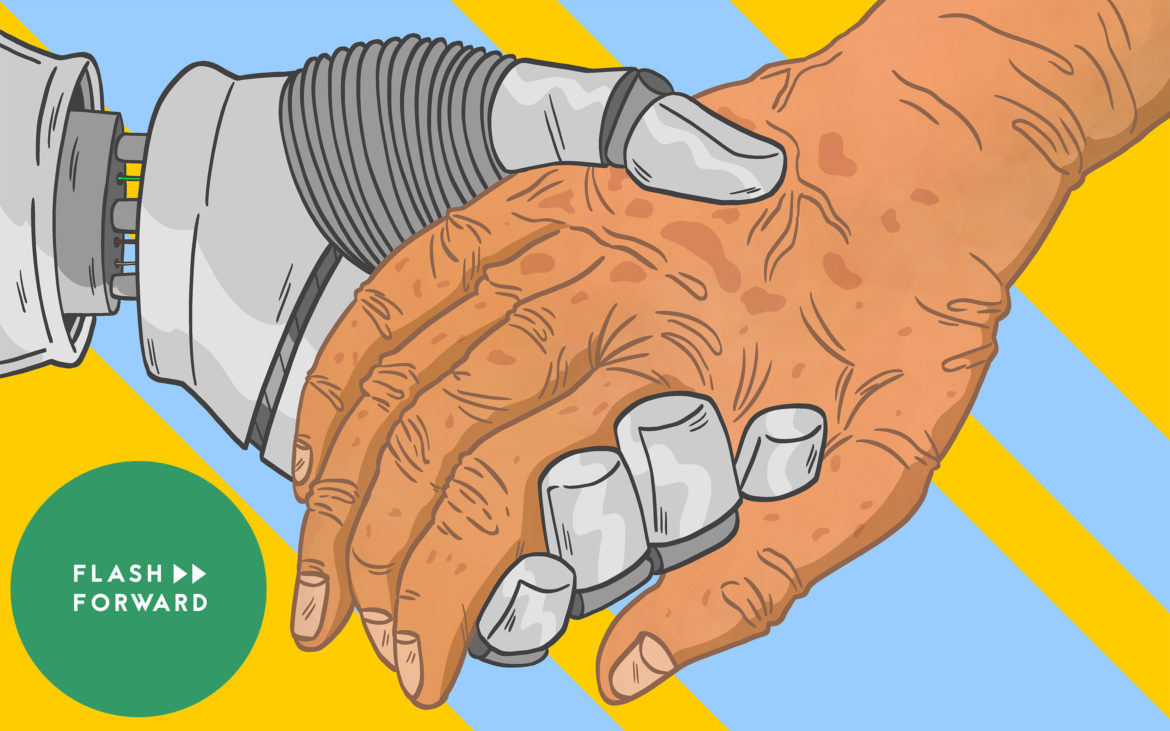
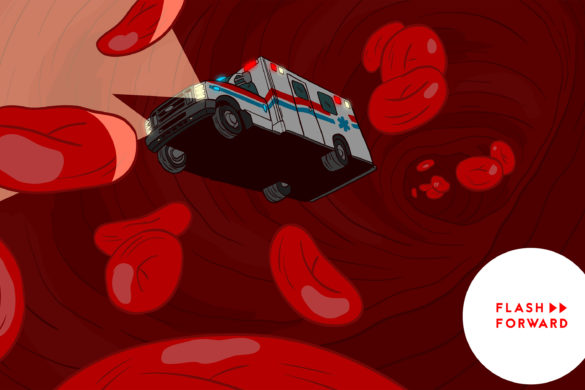
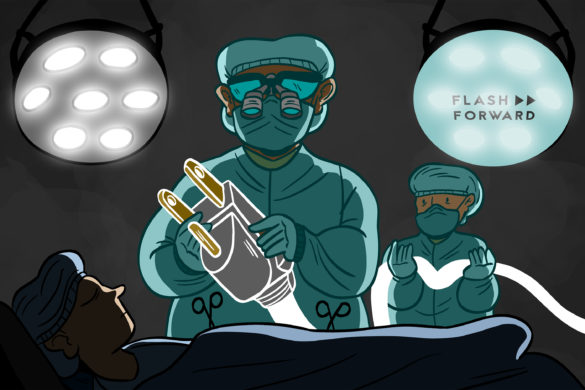

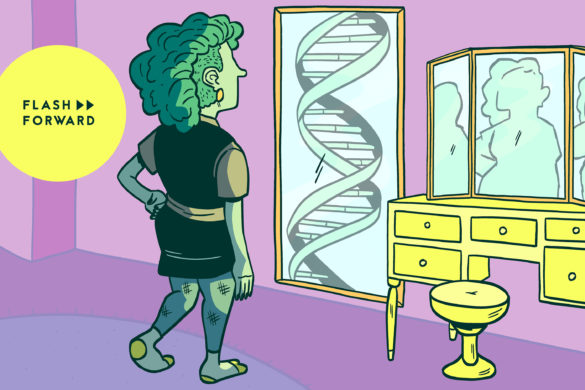
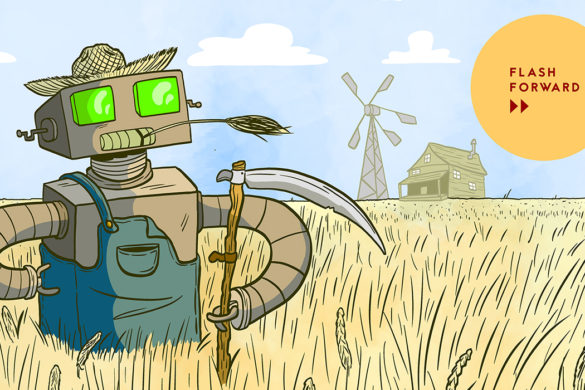
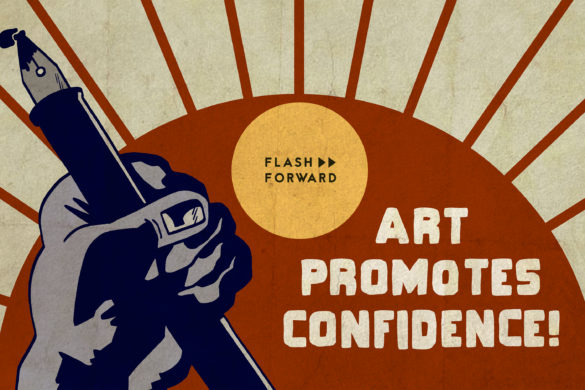

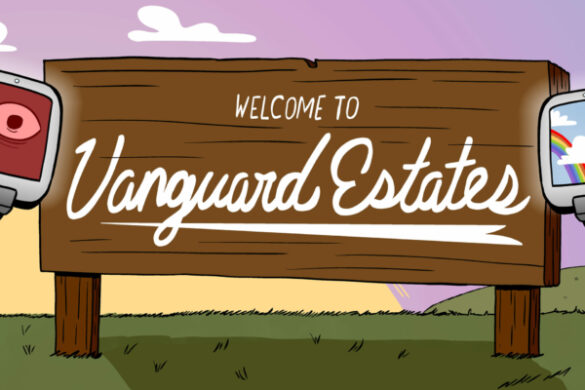
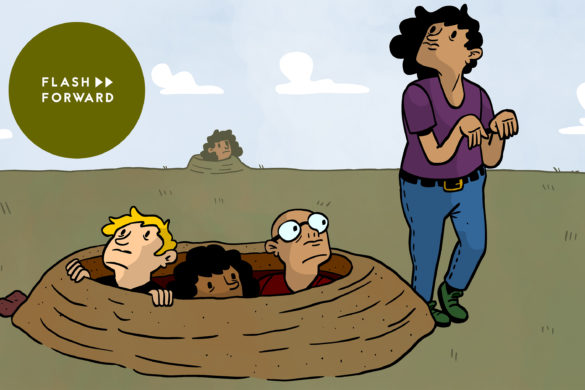
11 comments
Thank you so much for this episode and talking about this topic.
It is a real shame how we talk about our elders. And how the media calls it an “aging epidemic” as if it isn’t the goal of all of us (most of us) to reach a nice old age in good health.
I would think a functioning “society” could find a way to raise money in our collective youths so that we could financially take care of our elderly without anybody having to drain their bank account.
The clip at the beginning of the episode leaned heavily into what is annoying and scary about the prospect of bad tech elder care, there are already more convincing interactions, IBM’s Watson and Stephen Hawking’s voice synthesizer sound much more human without sitting in the uncanny valley. You should watch the movie Robot & Frank with Frank Langella and the first season of the show Humans with William Hurt or even Moon with Kevin Spacey (Yes, I’m trying to figure out how to separate the artist from the work in his case, might never watch House of Cards). I like to think I’ll be comfortable with non-human assistance as long as there is still human interaction in my day, someone to cook for or with occasionally, going to share a movie or live performance with an actual audience. I am also trying to cultivate actual shared interests with my children so we won’t have to manufacture quality time. I write code for a living so I can pretty much keep working at some pace as long as my typing skills, vision, and brain keep chugging along. Uninvited Guests, while cute, would be a dystopia, people would cheat, as we saw. The bed should have been checking for heartbeats or movement, the fork should have detected it was never moving enough to reach a mouth, and the cane should detect when it is used too far from the phone. Love the podcast, hope to make a live show soon.
[…] This is a common cycle in technology, more broadly. Over and over again, designers claim their products will be great for an aging population without actually including that population in the conversation. “I think there’s been a lot of new technologies being marketed toward older adults but that haven’t necessarily been designed for them, with their capabilities in mind,” Wendy Rogers, a professor at the University of Illinois, told me for an episode of my podcast Flash Forward. […]
[…] This can be a widespread cycle in expertise, extra broadly. Time and again, designers declare their merchandise shall be nice for an growing old inhabitants with out really together with that inhabitants within the dialog. “I believe there’s been quite a lot of new applied sciences being marketed towards older adults however that haven’t essentially been designed for them, with their capabilities in thoughts,” Wendy Rogers, a professor on the College of Illinois, informed me for an episode of my podcast Flash Ahead. […]
[…] This is a common cycle in technology, more broadly. Over and over again, designers claim their products will be great for an aging population without actually including that population in the conversation. “I think there’s been a lot of new technologies being marketed toward older adults but that haven’t necessarily been designed for them, with their capabilities in mind,” Wendy Rogers, a professor at the University of Illinois, told me for an episode of my podcast Flash Forward. […]
[…] This is a common cycle in technology, more broadly. Over and over again, designers claim their products will be great for an aging population without actually including that population in the conversation. “I think there’s been a lot of new technologies being marketed toward older adults but that haven’t necessarily been designed for them, with their capabilities in mind,” Wendy Rogers, a professor at the University of Illinois, told me for an episode of my podcast Flash Forward. […]
[…] This is a common cycle in technology, more broadly. Over and over again, designers claim their products will be great for an aging population without actually including that population in the conversation. “I think there’s been a lot of new technologies being marketed toward older adults but that haven’t necessarily been designed for them, with their capabilities in mind,” Wendy Rogers, a professor at the University of Illinois, told me for an episode of my podcast Flash Forward. […]
[…] This is a common cycle in technology, more broadly. Over and over again, designers claim their products will be great for an aging population without actually including that population in the conversation. “I think there’s been a lot of new technologies being marketed toward older adults but that haven’t necessarily been designed for them, with their capabilities in mind,” Wendy Rogers, a professor at the University of Illinois, told me for an episode of my podcast Flash Forward. […]
[…] Here is a general cycle in technology, extra broadly. Time and all yet again, designers claim their merchandise could be enormous for an rising older population with out genuinely along side that population within the conversation. “I deem there’s been quite loads of most modern applied sciences being marketed toward older adults however that haven’t basically been designed for them, with their capabilities in mind,” Wendy Rogers, a professor on the College of Illinois, suggested me for an episode of my podcast Flash Forward. […]
[…] This is a common cycle in technology, more broadly. Over and over again, designers claim their products will be great for an aging population without actually including that population in the conversation. “I think there’s been a lot of new technologies being marketed toward older adults but that haven’t necessarily been designed for them, with their capabilities in mind,” Wendy Rogers, a professor at the University of Illinois, told me for an episode of my podcast Flash Forward. […]
[…] The Grey Dawn (Flash Forward episode) […]